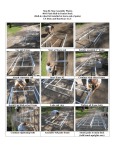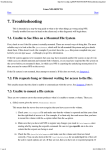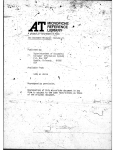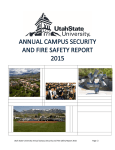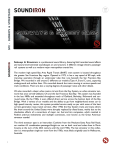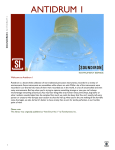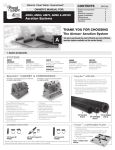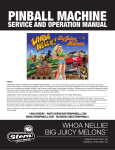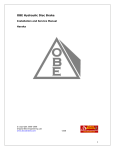Download Notes From the Road - CNET Content Solutions
Transcript
Notes From the Road Preparing the Family Car for that Summer Road Trip By: Aaron Robinson The summer road trip is as American as apple pie and Fourth of July fireworks, so don’t fail in your national duty to hit the road this year just because Old Nellie is overdue for some care and maintenance. Those who neglect doing a quick mechanical checkover – even of newer cars – before taking to the highway, are just begging to be stranded. Most likely in the desert, just out of range of the nearest cell tower, with vultures circling overhead in the otherwise azureblue sky, which would be postcard perfect if you weren’t worried about having your eyes pecked out. So what does Old Nellie want? We’re not talking about rebuilding the cylinder head or performing a linebore on the crankshaft mains. Below are just a few reminders that may slip your mental checklist in the rush to get bags packed, kids fed, grandma watered, and all the maps folded the way they were when new. “The most critical areas to check before going on a driving trip are engine fluids, radiator hoses, belts, tires and brakes,” says Pat Goss, car care guru and cohost of PBS’s MotorWeek TV show. “Adequately preparing these key areas of the car before you leave for your trip will not only keep you safe while driving on vacation, they’ll help prevent costly repairs. No one wants to spend money fixing their car during a vacation.” Goss has probably never broken down in his life, so we’ll take him at his word. And no eyerolling at the expense you think will be involved. This is probably going to cost less than what you spent on French fries last week, so get to it. Your family is counting on you to take a few preventative measures before you hurl them into the gauntlet of our national highway system. Synthetic Engine Oil – Check your oil levels and the date you’re due for an oil change, preferably in your driveway before you embark on that first 29hour leg. If you’re close to the manufacturerrecommended oilchange interval listed in your manual (you do read your manual, don’t you?), then change it. Don’t think about it, just do it. Nellie deserves better than a crankcase full of gunky old oil as she hauls your carcass up the Loveland Pass. If you’ll be going long distances, consider opting for synthetic. If you are traveling in hot weather – and where is it not hot in America in the summer? – and especially if you’re pulling a trailer, a fully synthetic engine oil such as Mobil 1 Extended Performance 5W30 for newer cars or the 10W 30 formula for higher mileage vehicles gives you some extra protection against thermal breakdown, or “coking,” during prolonged highspeed runs in hot temperatures. It also will cut friction losses in the engine and bump your fuel economy, savings that you’ll see magnified on a long drive. And since synthetic oils have longer duty cycles, you should be able to complete your tour of America’s best donutandkaraoke shops on one oil change, secure that Old Nellie is well lubricated Transmission and differential fluids – Did you forget about the other oil reservoirs in your car? Both your transmission and drive axle have their own lubricant supply. Check your owner’s manual for their change intervals, as they are quite a bit longer than engine oil, but if Nellie has over 75,000 miles and you’ve never checked or changed her other lubricants, it’s time to get busy. Automatic transmissions require special redcolored ATF fluid, and changing it and the transmission filter are best left to a professional mechanic. It’s a messy, stinky job that you wouldn’t want to do anyway, and getting it wrong is going to cost you big. A regular oilchange shop can handle the greasy job of changing manual transmission oil and the differential oil. While they are under the car, have them give the driveshaft Ujoints and any other grease points a squirt of grease. Hoses – Don’t just confirm that they are still there. Look close. Rubber hoses would last 10 years if all they did was sit on a shelf. In a car, they are regularly exposed to temperatures around the 212degree boiling point. At high temps, the plasticizers that make rubber squishy leach out at a faster rate. Once a hose gets hard, it cracks, hot water spurts out, and the vultures grab their forks. Look first at where both the input and output radiator hoses attach to the engine and to the radiator. The extra stress on the hose from the pipe collar and hose clamp means they typically crack and fail there first. Also check your heater hoses, which run from the engine (usually near the thermostat housing) into the firewall and back. Look for bulges or blisters, which indicate a weakness in the hose wall. If your hoses have cracks or blisters, replace them. It’s easier to do it now than in the 112degree heat of Death Valley. As a precaution, buy a hosepatch kit at the local auto parts store. Belts Not your waist belt, the engine belts. Check them by turning them sideways with your hand so you can see the friction surface. If it’s at all ragged, torn, cracked, or showing the fiber cords, it’s time for fresh ones. Newer cars often have one large belt, called a serpentine, which runs the water pump and all the accessories (A/C, power steering, and alternator). If your car has less than 50,000 miles, it’s probably fine. Older cars have more than one belt to run these devices. Make sure they are all in good condition. If you hear loud screeches of agony when you pull away from a stop light, a loose belt is probably the cause. If they are loose – in other words, if your finger can depress the belt more than a halfinch of deflection at a point halfway between pulleys – the belt is stretched. If it’s old and worn, replace it. If it’s not, you’ll have to retension it or it may fall off, usually at a really inopportune moment such as in the 2mile backup at the turnpike toll booth. Tensioning may involve loosening the accessory, levering it with a large stick or the shaft of a hammer, and retightening. Consult your service manual or turn it over to a trusted mechanic. Carrying an extra set of belts along is inexpensive insurance. Engine coolant New vehicles come equipped with engine coolant designed to go 100,000 to 150,000 miles. If your car is less than four years old, just check that the underhood coolant reservoir – usually a clear plastic bottle that says “engine coolant” on the cap – is topped up. Water is water, right? Wrong. Not all coolants are the same, and they don’t want to be mixed. Trust us on that one. Be sure to use the same coolant type as is already in the engine. You can tell the difference from the color. Green coolant is the most common, indicating an ethylene glycolbased coolant with a standard package of rust inhibitors. Orange is a newer type called DexCool, originally developed by General Motors but manufactured by other coolant name brands under license. The jug should have a large “DexCool” trademark on it. It is also ethylene glycolbased, but has an enhanced package of corrosion inhibitors (and, hence, tends to be more expensive). If you have an older vehicle, check both the coolant reservoir and the radiator. If your coolant is rustcolored or looks like mucky pond water, it’s time for a change. Coolant performs several complex functions, including cooling the engine (thus the highly descriptive name), preventing rust, preventing freezing, and lubricating the water pump. The longer you drive on old coolant, the more damage you do. So change it following the instructions on the jug and in your service manual. Make sure you get all the old stuff out, which means draining the engine block, not just the radiator. And while it’s out, flush the radiator and coolant galleries with a garden hose, leaving all the taps open until the water runs clear. (Never open your radiator when the engine is warm. Only remove the radiator cap when the engine has cooled down. Steam and hot coolant can cause burns.) Then refill using a 50/50 water/antifreeze mix and run it with the cap off until the air bubbles are out. If your thermostat is old or has given any sign of failure in the past, such as higher temp readings or no heat from the heater, also replace that. Don’t just dump the coolant down the drain or the nearest sewer. Ethyleneglycol is toxic – and it’s also recyclable – so take it to an approved dropoff location. Some states require service shops to take it in, and most towns have a household hazardous waste dropoff point. Tire Pressure and Tread – Tires are your contact with the road, and since losing contact generally results in the remains of your vehicle being swept up with a Dust Buster, check ‘em out. Most people believe the appropriate tire pressure is listed on the tire itself. Actually, the number on the tire is the maximum amount of pressure the tire can hold and, if combined with extreme heat and speeds, can lead to a blowout. Be safe. Look on your driver’s side door, in the glove compartment, or on the fuel filler door for the recommended tire pressures, and check the pressure before you leave with a good gauge (available from your auto parts store) and an air hose (available at the corner gas station). Low tire pressures waste fuel and, more importantly, cause the tire to run hotter from the extra friction. That can lead to a blowout. Also, look at the tread on all four tires to make sure it’s not too worn or unevenly worn. Most new tires come with about 10/32” of tread depth. If your tire treaddepth gauge (just a buck or two at the parts store) shows less than 2/32”, it’s time to visit Mr. Tire Guy. You can also use a penny. If the depth is below Lincoln’s shoulder, it’s time to change. If your tires are on the bubble in terms of wear, or have a bubble in the sidewall from a recent bounce against a curb, it’s best to install new tires now than to take a chance on them wearing out while you’re on the road. Okay, this may cost a bit more than what you spent on last week’s French fries, but it’s money that is very wellspent. Brake System – Brake fluid classified by the government as DOT3 or DOT4 (most brake fluid, in other words) is a hygroscopic mineral oil, meaning that it attracts and absorbs moisture. As it ages, it turns the color of maple syrup and begins rusting out your brake components. Rusted brakes, by the way, are bad. Check your brake reservoir for the color of the fluid and make sure that it is topped up to the “full” mark. If you haven’t had a flush in the two or three years, get one before you leave. Waterladen brake fluid, besides causing damage to very costly brake parts, also lowers the fluid’s boiling point. A lowered boiling point can lead to a squishy brake pedal, which may provide more excitement than you want while descending out of the Rockies with a 24foot camper in tow. If your car is newer, it may be running DOT5 fluid, which is siliconbased and not subject to water absorption. Still, you will want to flush this fluid per the recommendations in your owner’s manual. Battery – If the battery in your car is more than a couple years old, check that the terminals are corrosionfree and the positive and negative leads are tight. If your starter sounds sluggish, it’s either corrosion or a kaput battery. Don’t wait to be stranded with a dead battery. If it’s not a sealed, maintenancefree battery, have a gas station test the electrolytes. If it is sealed, they can check the output voltage. If there is corrosion – white chalky stuff on the terminals – clean it off with a wire cablebrush available at your local parts store. Secure the leads tightly. If one falls off while you are driving, it can cause a harmful “voltage dump” which can kill the alternator, so make sure everything is tight. Test the car – Do a quick run up the local freeway to listen for noises, feel for shakes, and watch for trouble signs in the gauges. Don’t assume everything is fine just because you drive your car every day. This is a test, not a commute, so put away the Fritos and turn off the “Don Ho In Central Park” CD. Focus on your car. Do you hear grinding or moaning from the wheels? Could be a bad wheel bearing or a worn CV joint. Does the car pull? Check for alignment problems or worn tires. Does it shimmy or squeal under braking? Might be warped rotors or worn pads. Does the brake pedal feel soft? Might mean worn pads or bad fluid. Do the headlights flicker at idle? Think: loose alternator belt, dying alternator, or corroded battery terminals. Consider checking off these items before you leave, because if Old Nellie acts up later, she could ruin your whole vacation. Family photos of America’s purple mountains’ majesty won’t put your relatives to sleep quite as quickly as those taken inside a grimy service station in Panguitch, Utah, while you’re waiting for a mechanic to get your new radiator hose dropshipped from Fukuoka. Take time, take care, and drive safely, and we’ll see you out there. Aaron Robinson has spent the past 15 years reporting on cars and the car industry, first for a national car dealer magazine, then for the weekly trade newspaper Automotive News, now as Technical Editor of the world's largest consumer car monthly, Car and Driver. When not hunched over a word processor, he's usually found in his garage trying to save worthless old cars from a welldeserved trip to the junkyard.




